MGT723 Research: Impact of Incentives on Carbon Emission in USA
VerifiedAdded on 2023/06/07
|10
|1940
|345
Report
AI Summary
This research project investigates the relationship between incentives provided to companies and their carbon emissions in the USA. A sample of 293 companies was analyzed, examining the percentage change in carbon dioxide emissions as the dependent variable and the presence of incentiv...
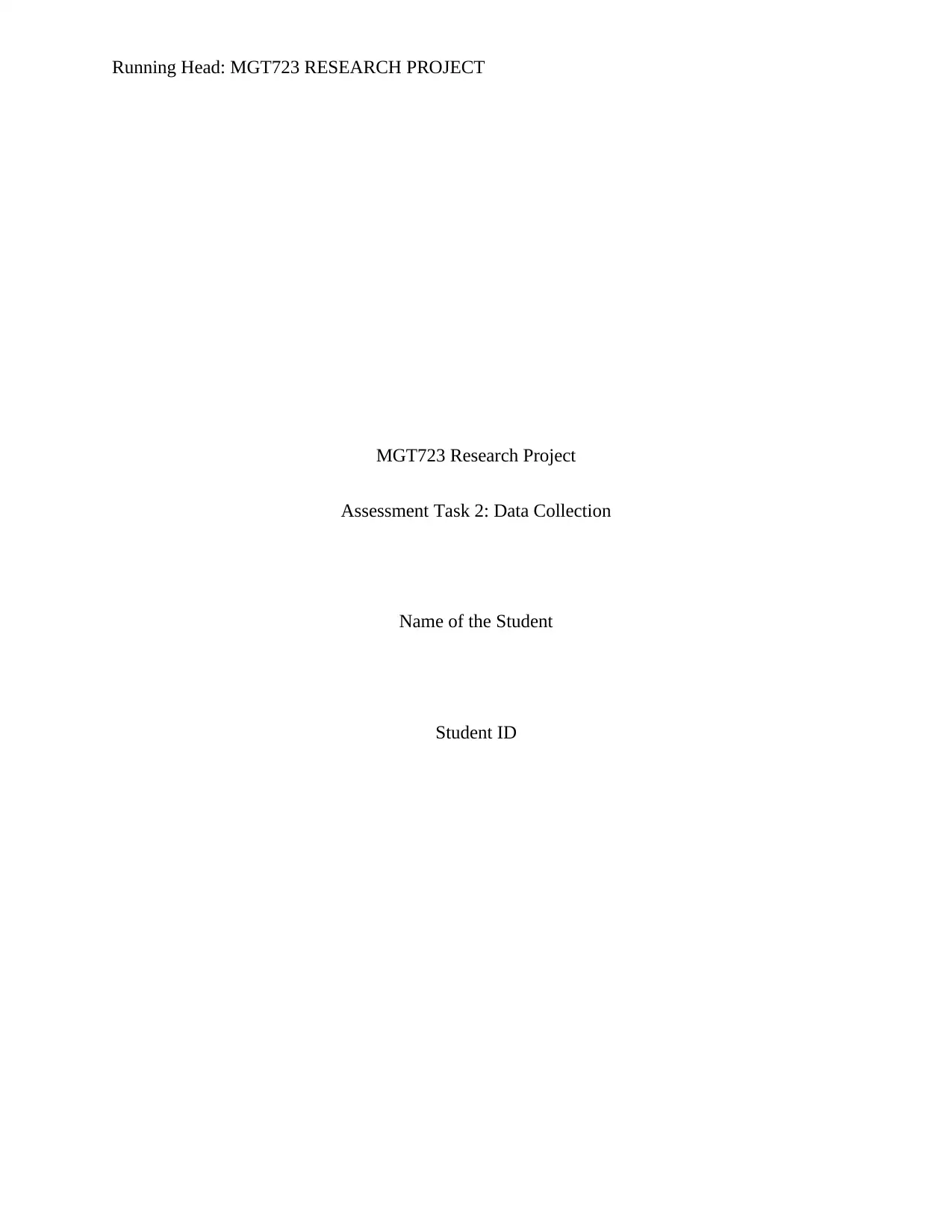
Running Head: MGT723 RESEARCH PROJECT
MGT723 Research Project
Assessment Task 2: Data Collection
Name of the Student
Student ID
MGT723 Research Project
Assessment Task 2: Data Collection
Name of the Student
Student ID
Paraphrase This Document
Need a fresh take? Get an instant paraphrase of this document with our AI Paraphraser
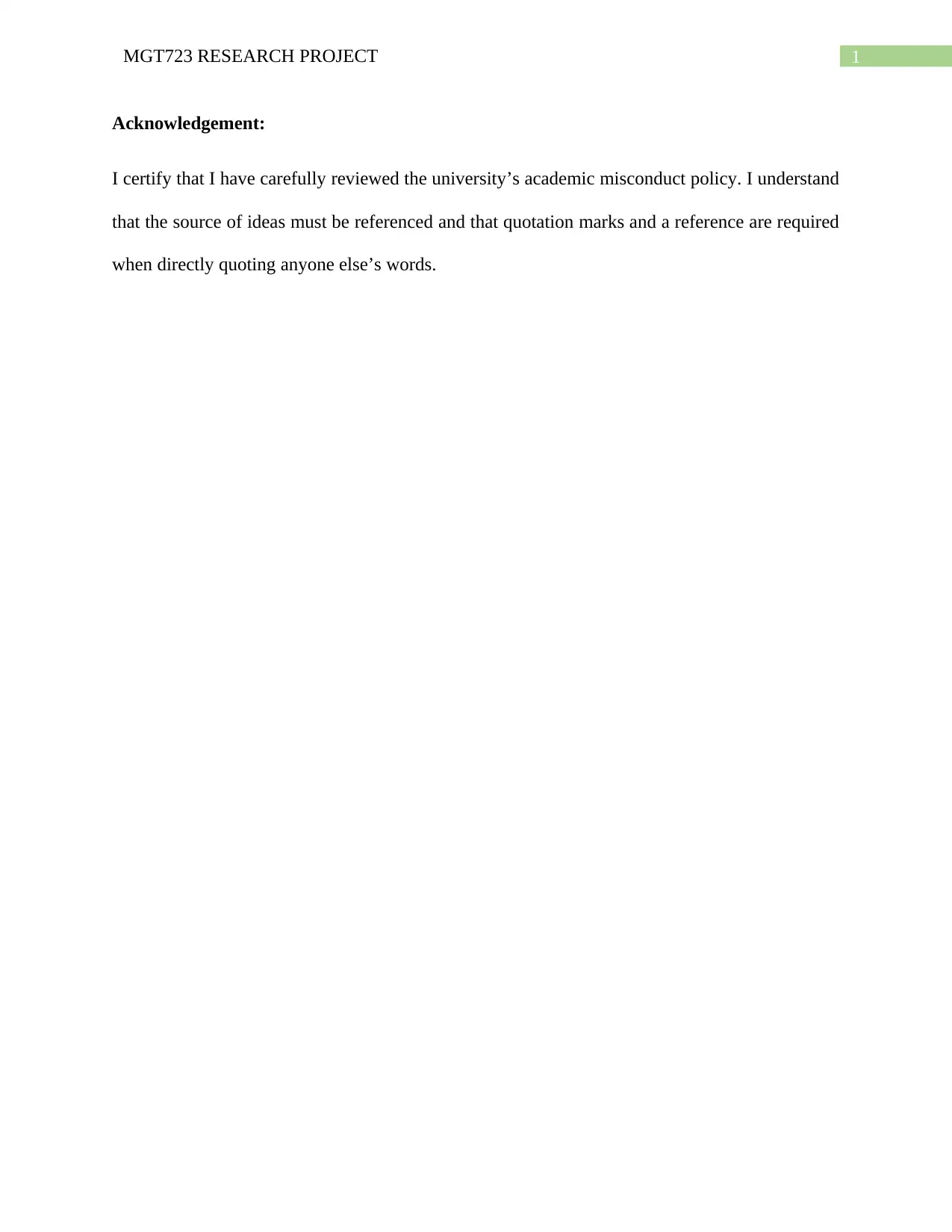
1MGT723 RESEARCH PROJECT
Acknowledgement:
I certify that I have carefully reviewed the university’s academic misconduct policy. I understand
that the source of ideas must be referenced and that quotation marks and a reference are required
when directly quoting anyone else’s words.
Acknowledgement:
I certify that I have carefully reviewed the university’s academic misconduct policy. I understand
that the source of ideas must be referenced and that quotation marks and a reference are required
when directly quoting anyone else’s words.
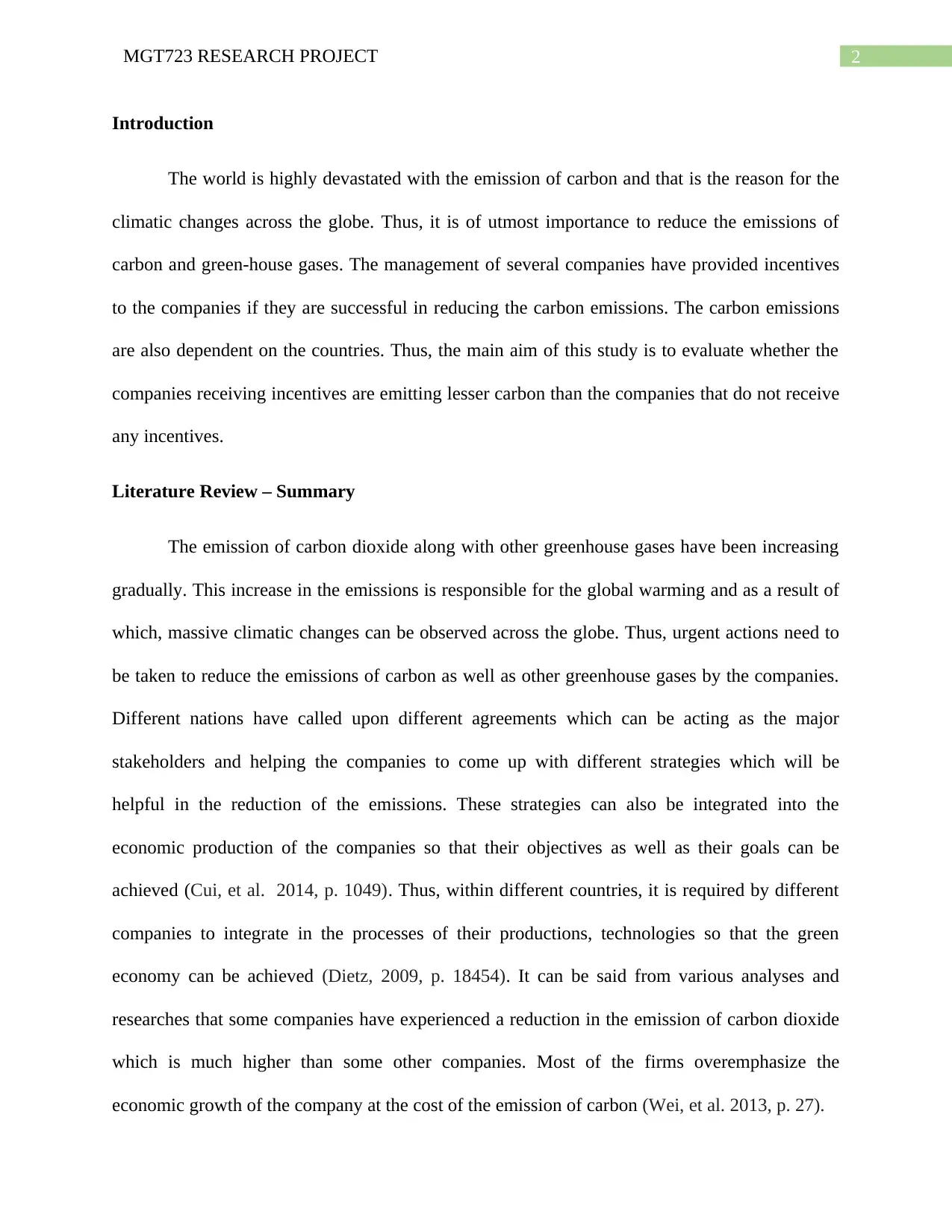
2MGT723 RESEARCH PROJECT
Introduction
The world is highly devastated with the emission of carbon and that is the reason for the
climatic changes across the globe. Thus, it is of utmost importance to reduce the emissions of
carbon and green-house gases. The management of several companies have provided incentives
to the companies if they are successful in reducing the carbon emissions. The carbon emissions
are also dependent on the countries. Thus, the main aim of this study is to evaluate whether the
companies receiving incentives are emitting lesser carbon than the companies that do not receive
any incentives.
Literature Review – Summary
The emission of carbon dioxide along with other greenhouse gases have been increasing
gradually. This increase in the emissions is responsible for the global warming and as a result of
which, massive climatic changes can be observed across the globe. Thus, urgent actions need to
be taken to reduce the emissions of carbon as well as other greenhouse gases by the companies.
Different nations have called upon different agreements which can be acting as the major
stakeholders and helping the companies to come up with different strategies which will be
helpful in the reduction of the emissions. These strategies can also be integrated into the
economic production of the companies so that their objectives as well as their goals can be
achieved (Cui, et al. 2014, p. 1049). Thus, within different countries, it is required by different
companies to integrate in the processes of their productions, technologies so that the green
economy can be achieved (Dietz, 2009, p. 18454). It can be said from various analyses and
researches that some companies have experienced a reduction in the emission of carbon dioxide
which is much higher than some other companies. Most of the firms overemphasize the
economic growth of the company at the cost of the emission of carbon (Wei, et al. 2013, p. 27).
Introduction
The world is highly devastated with the emission of carbon and that is the reason for the
climatic changes across the globe. Thus, it is of utmost importance to reduce the emissions of
carbon and green-house gases. The management of several companies have provided incentives
to the companies if they are successful in reducing the carbon emissions. The carbon emissions
are also dependent on the countries. Thus, the main aim of this study is to evaluate whether the
companies receiving incentives are emitting lesser carbon than the companies that do not receive
any incentives.
Literature Review – Summary
The emission of carbon dioxide along with other greenhouse gases have been increasing
gradually. This increase in the emissions is responsible for the global warming and as a result of
which, massive climatic changes can be observed across the globe. Thus, urgent actions need to
be taken to reduce the emissions of carbon as well as other greenhouse gases by the companies.
Different nations have called upon different agreements which can be acting as the major
stakeholders and helping the companies to come up with different strategies which will be
helpful in the reduction of the emissions. These strategies can also be integrated into the
economic production of the companies so that their objectives as well as their goals can be
achieved (Cui, et al. 2014, p. 1049). Thus, within different countries, it is required by different
companies to integrate in the processes of their productions, technologies so that the green
economy can be achieved (Dietz, 2009, p. 18454). It can be said from various analyses and
researches that some companies have experienced a reduction in the emission of carbon dioxide
which is much higher than some other companies. Most of the firms overemphasize the
economic growth of the company at the cost of the emission of carbon (Wei, et al. 2013, p. 27).
⊘ This is a preview!⊘
Do you want full access?
Subscribe today to unlock all pages.

Trusted by 1+ million students worldwide
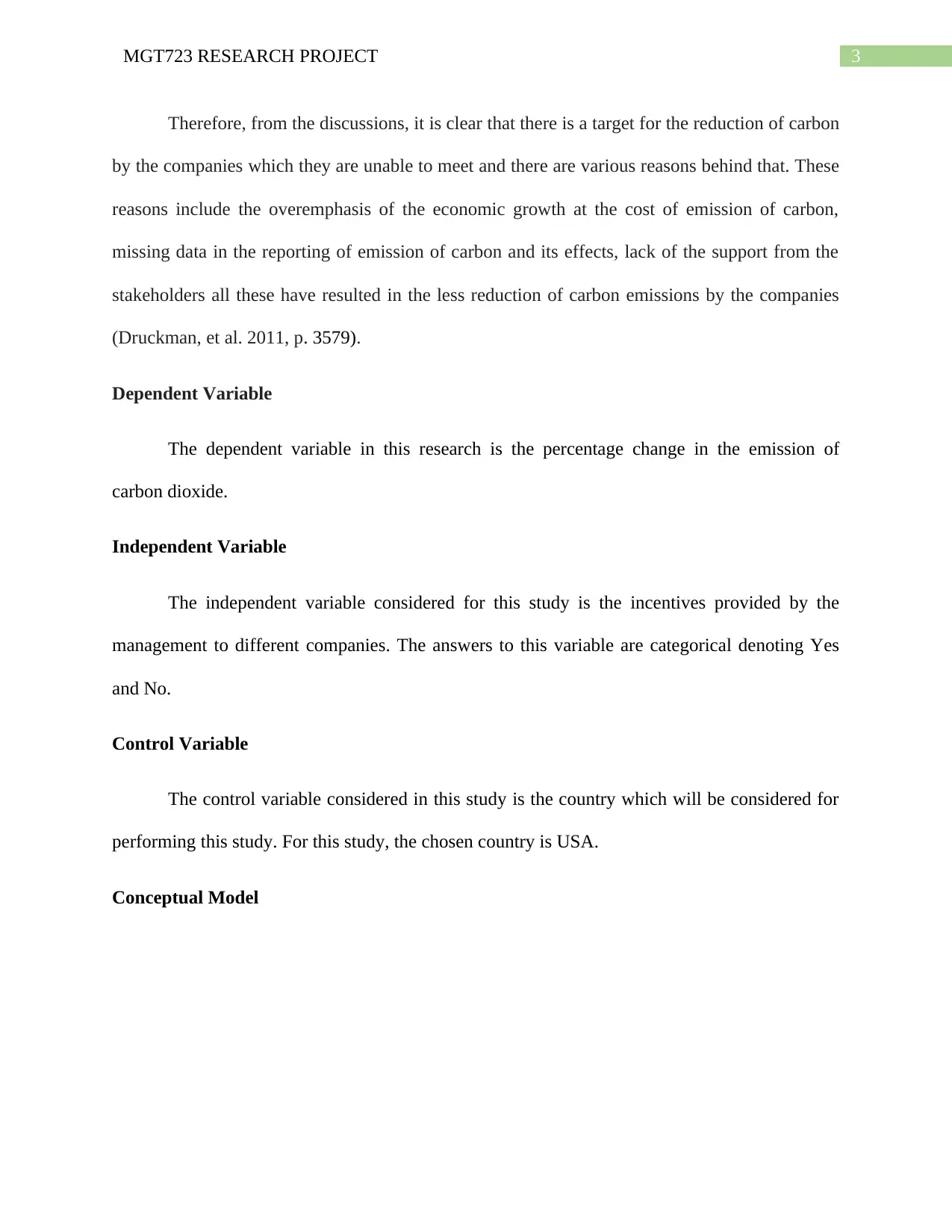
3MGT723 RESEARCH PROJECT
Therefore, from the discussions, it is clear that there is a target for the reduction of carbon
by the companies which they are unable to meet and there are various reasons behind that. These
reasons include the overemphasis of the economic growth at the cost of emission of carbon,
missing data in the reporting of emission of carbon and its effects, lack of the support from the
stakeholders all these have resulted in the less reduction of carbon emissions by the companies
(Druckman, et al. 2011, p. 3579).
Dependent Variable
The dependent variable in this research is the percentage change in the emission of
carbon dioxide.
Independent Variable
The independent variable considered for this study is the incentives provided by the
management to different companies. The answers to this variable are categorical denoting Yes
and No.
Control Variable
The control variable considered in this study is the country which will be considered for
performing this study. For this study, the chosen country is USA.
Conceptual Model
Therefore, from the discussions, it is clear that there is a target for the reduction of carbon
by the companies which they are unable to meet and there are various reasons behind that. These
reasons include the overemphasis of the economic growth at the cost of emission of carbon,
missing data in the reporting of emission of carbon and its effects, lack of the support from the
stakeholders all these have resulted in the less reduction of carbon emissions by the companies
(Druckman, et al. 2011, p. 3579).
Dependent Variable
The dependent variable in this research is the percentage change in the emission of
carbon dioxide.
Independent Variable
The independent variable considered for this study is the incentives provided by the
management to different companies. The answers to this variable are categorical denoting Yes
and No.
Control Variable
The control variable considered in this study is the country which will be considered for
performing this study. For this study, the chosen country is USA.
Conceptual Model
Paraphrase This Document
Need a fresh take? Get an instant paraphrase of this document with our AI Paraphraser
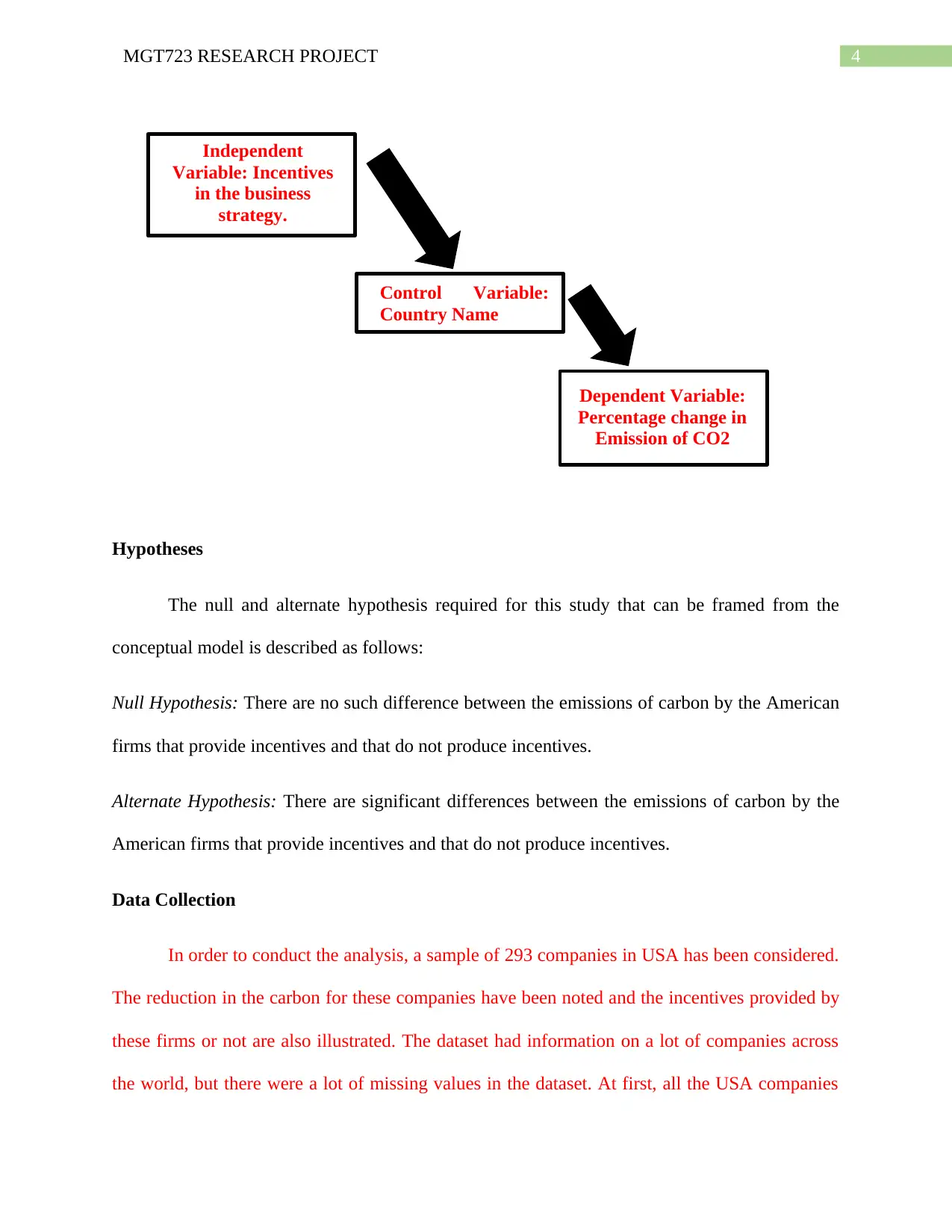
4MGT723 RESEARCH PROJECT
Independent
Variable: Incentives
in the business
strategy.
Control Variable:
Country Name
Dependent Variable:
Percentage change in
Emission of CO2
Hypotheses
The null and alternate hypothesis required for this study that can be framed from the
conceptual model is described as follows:
Null Hypothesis: There are no such difference between the emissions of carbon by the American
firms that provide incentives and that do not produce incentives.
Alternate Hypothesis: There are significant differences between the emissions of carbon by the
American firms that provide incentives and that do not produce incentives.
Data Collection
In order to conduct the analysis, a sample of 293 companies in USA has been considered.
The reduction in the carbon for these companies have been noted and the incentives provided by
these firms or not are also illustrated. The dataset had information on a lot of companies across
the world, but there were a lot of missing values in the dataset. At first, all the USA companies
Independent
Variable: Incentives
in the business
strategy.
Control Variable:
Country Name
Dependent Variable:
Percentage change in
Emission of CO2
Hypotheses
The null and alternate hypothesis required for this study that can be framed from the
conceptual model is described as follows:
Null Hypothesis: There are no such difference between the emissions of carbon by the American
firms that provide incentives and that do not produce incentives.
Alternate Hypothesis: There are significant differences between the emissions of carbon by the
American firms that provide incentives and that do not produce incentives.
Data Collection
In order to conduct the analysis, a sample of 293 companies in USA has been considered.
The reduction in the carbon for these companies have been noted and the incentives provided by
these firms or not are also illustrated. The dataset had information on a lot of companies across
the world, but there were a lot of missing values in the dataset. At first, all the USA companies
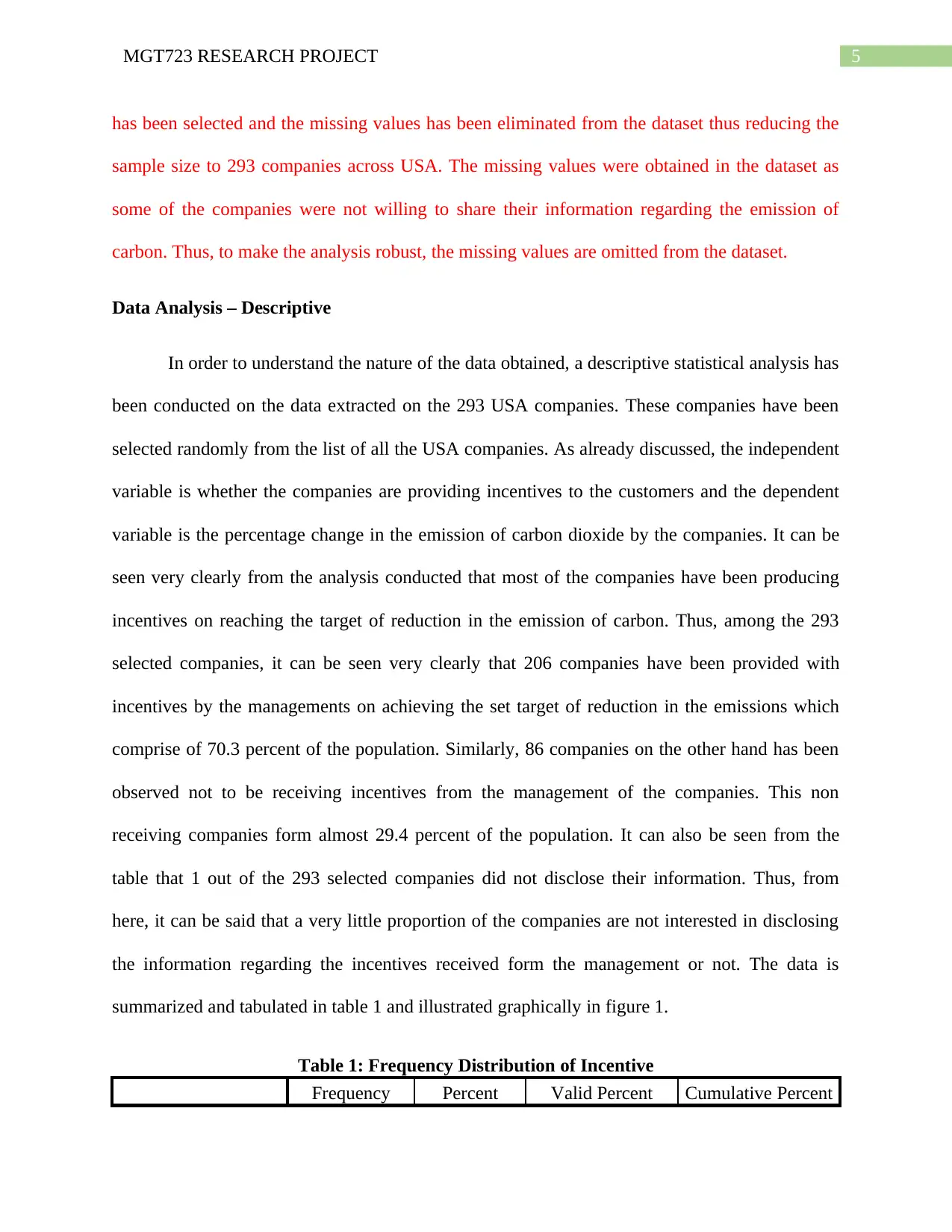
5MGT723 RESEARCH PROJECT
has been selected and the missing values has been eliminated from the dataset thus reducing the
sample size to 293 companies across USA. The missing values were obtained in the dataset as
some of the companies were not willing to share their information regarding the emission of
carbon. Thus, to make the analysis robust, the missing values are omitted from the dataset.
Data Analysis – Descriptive
In order to understand the nature of the data obtained, a descriptive statistical analysis has
been conducted on the data extracted on the 293 USA companies. These companies have been
selected randomly from the list of all the USA companies. As already discussed, the independent
variable is whether the companies are providing incentives to the customers and the dependent
variable is the percentage change in the emission of carbon dioxide by the companies. It can be
seen very clearly from the analysis conducted that most of the companies have been producing
incentives on reaching the target of reduction in the emission of carbon. Thus, among the 293
selected companies, it can be seen very clearly that 206 companies have been provided with
incentives by the managements on achieving the set target of reduction in the emissions which
comprise of 70.3 percent of the population. Similarly, 86 companies on the other hand has been
observed not to be receiving incentives from the management of the companies. This non
receiving companies form almost 29.4 percent of the population. It can also be seen from the
table that 1 out of the 293 selected companies did not disclose their information. Thus, from
here, it can be said that a very little proportion of the companies are not interested in disclosing
the information regarding the incentives received form the management or not. The data is
summarized and tabulated in table 1 and illustrated graphically in figure 1.
Table 1: Frequency Distribution of Incentive
Frequency Percent Valid Percent Cumulative Percent
has been selected and the missing values has been eliminated from the dataset thus reducing the
sample size to 293 companies across USA. The missing values were obtained in the dataset as
some of the companies were not willing to share their information regarding the emission of
carbon. Thus, to make the analysis robust, the missing values are omitted from the dataset.
Data Analysis – Descriptive
In order to understand the nature of the data obtained, a descriptive statistical analysis has
been conducted on the data extracted on the 293 USA companies. These companies have been
selected randomly from the list of all the USA companies. As already discussed, the independent
variable is whether the companies are providing incentives to the customers and the dependent
variable is the percentage change in the emission of carbon dioxide by the companies. It can be
seen very clearly from the analysis conducted that most of the companies have been producing
incentives on reaching the target of reduction in the emission of carbon. Thus, among the 293
selected companies, it can be seen very clearly that 206 companies have been provided with
incentives by the managements on achieving the set target of reduction in the emissions which
comprise of 70.3 percent of the population. Similarly, 86 companies on the other hand has been
observed not to be receiving incentives from the management of the companies. This non
receiving companies form almost 29.4 percent of the population. It can also be seen from the
table that 1 out of the 293 selected companies did not disclose their information. Thus, from
here, it can be said that a very little proportion of the companies are not interested in disclosing
the information regarding the incentives received form the management or not. The data is
summarized and tabulated in table 1 and illustrated graphically in figure 1.
Table 1: Frequency Distribution of Incentive
Frequency Percent Valid Percent Cumulative Percent
⊘ This is a preview!⊘
Do you want full access?
Subscribe today to unlock all pages.

Trusted by 1+ million students worldwide
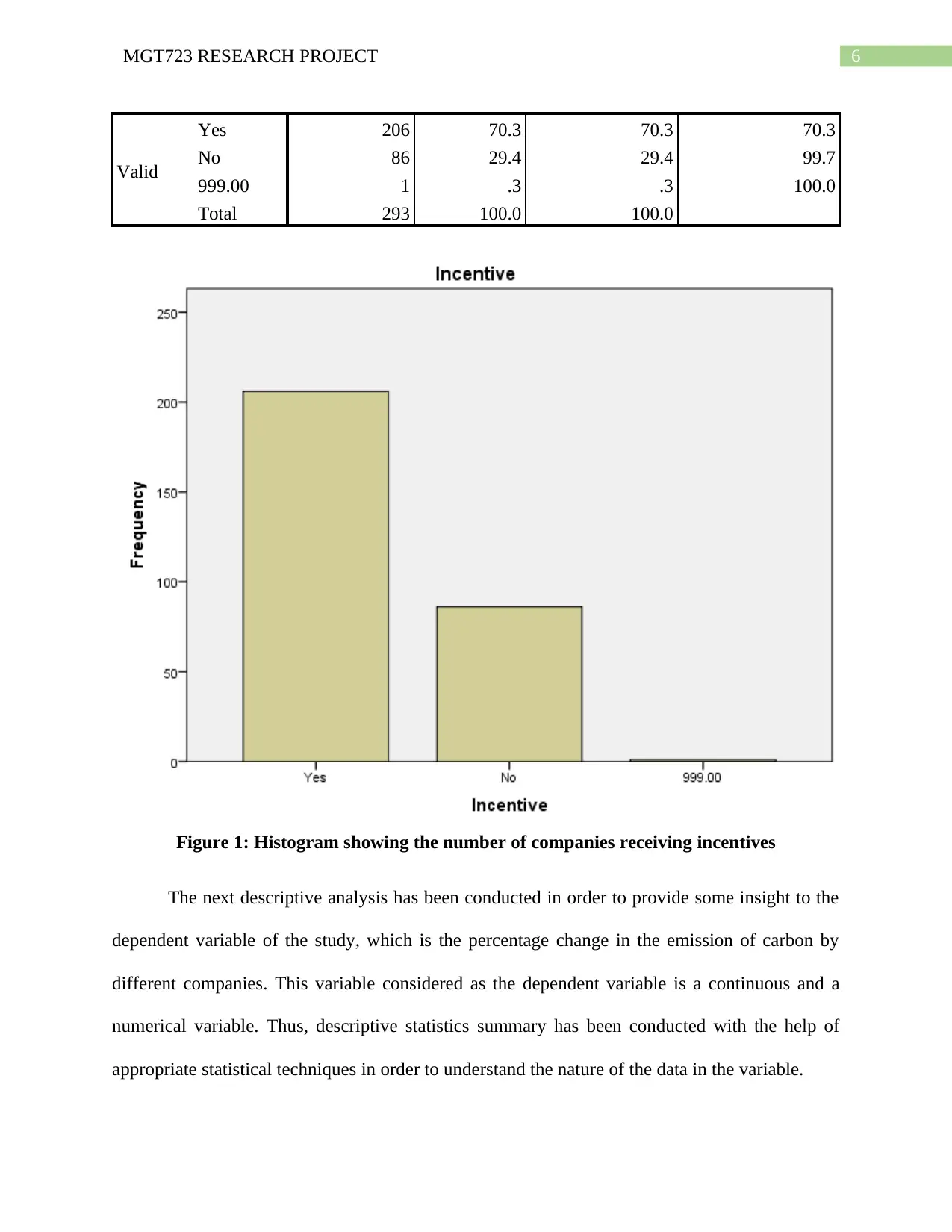
6MGT723 RESEARCH PROJECT
Valid
Yes 206 70.3 70.3 70.3
No 86 29.4 29.4 99.7
999.00 1 .3 .3 100.0
Total 293 100.0 100.0
Figure 1: Histogram showing the number of companies receiving incentives
The next descriptive analysis has been conducted in order to provide some insight to the
dependent variable of the study, which is the percentage change in the emission of carbon by
different companies. This variable considered as the dependent variable is a continuous and a
numerical variable. Thus, descriptive statistics summary has been conducted with the help of
appropriate statistical techniques in order to understand the nature of the data in the variable.
Valid
Yes 206 70.3 70.3 70.3
No 86 29.4 29.4 99.7
999.00 1 .3 .3 100.0
Total 293 100.0 100.0
Figure 1: Histogram showing the number of companies receiving incentives
The next descriptive analysis has been conducted in order to provide some insight to the
dependent variable of the study, which is the percentage change in the emission of carbon by
different companies. This variable considered as the dependent variable is a continuous and a
numerical variable. Thus, descriptive statistics summary has been conducted with the help of
appropriate statistical techniques in order to understand the nature of the data in the variable.
Paraphrase This Document
Need a fresh take? Get an instant paraphrase of this document with our AI Paraphraser

7MGT723 RESEARCH PROJECT
Table 2 gives the information and the results of the descriptive statistical analysis. It can
be seen from the table that the average change in percentage of the carbon by the companies is -
2.63 percent, which is a negative amount indicating that in most of the firms, there has been a
reduction in the emission of carbon from the previous years and the reductions in the emissions
has dominated the non-reductions in the 86 other firms. On the other hand, it can be seen clearly
from the results that the median percentage change in the carbon emission has also been found to
be negative (- 3.5 percent). This indicates that in 50 percent of the firms, the change in carbon
emission is more than – 3.5 percent, which indicates that in most of the firms there has been a
reduction in the emission of carbon. Thus, there must be outliers present in the data which is
affecting the mean measure. In other words, there are some companies which have been emitting
carbon a lot higher than the previous years and thus the reduced companies are not being affected
by this information. Moreover, it can also be seen from the standard deviation value that the
deviation in the data is extremely high and the values are not at all close to the average
percentage change in carbon emission. The value of skewness shows that the data on percentage
change in the emission of carbon by the companies is skewed positively. That is, more
companies have reduced the emission, while lesser companies have increased the emission.
Table 2: Summary Statistics on Percentage Change in Carbon Emission
Carbon_Reduction
N Valid 293
Missing 0
Mean -2.6289
Std. Error of Mean 2.58926
Median -3.5000
Mode .00
Std. Deviation 44.32092
Variance 1964.344
Skewness 12.512
Std. Error of Skewness .142
Table 2 gives the information and the results of the descriptive statistical analysis. It can
be seen from the table that the average change in percentage of the carbon by the companies is -
2.63 percent, which is a negative amount indicating that in most of the firms, there has been a
reduction in the emission of carbon from the previous years and the reductions in the emissions
has dominated the non-reductions in the 86 other firms. On the other hand, it can be seen clearly
from the results that the median percentage change in the carbon emission has also been found to
be negative (- 3.5 percent). This indicates that in 50 percent of the firms, the change in carbon
emission is more than – 3.5 percent, which indicates that in most of the firms there has been a
reduction in the emission of carbon. Thus, there must be outliers present in the data which is
affecting the mean measure. In other words, there are some companies which have been emitting
carbon a lot higher than the previous years and thus the reduced companies are not being affected
by this information. Moreover, it can also be seen from the standard deviation value that the
deviation in the data is extremely high and the values are not at all close to the average
percentage change in carbon emission. The value of skewness shows that the data on percentage
change in the emission of carbon by the companies is skewed positively. That is, more
companies have reduced the emission, while lesser companies have increased the emission.
Table 2: Summary Statistics on Percentage Change in Carbon Emission
Carbon_Reduction
N Valid 293
Missing 0
Mean -2.6289
Std. Error of Mean 2.58926
Median -3.5000
Mode .00
Std. Deviation 44.32092
Variance 1964.344
Skewness 12.512
Std. Error of Skewness .142
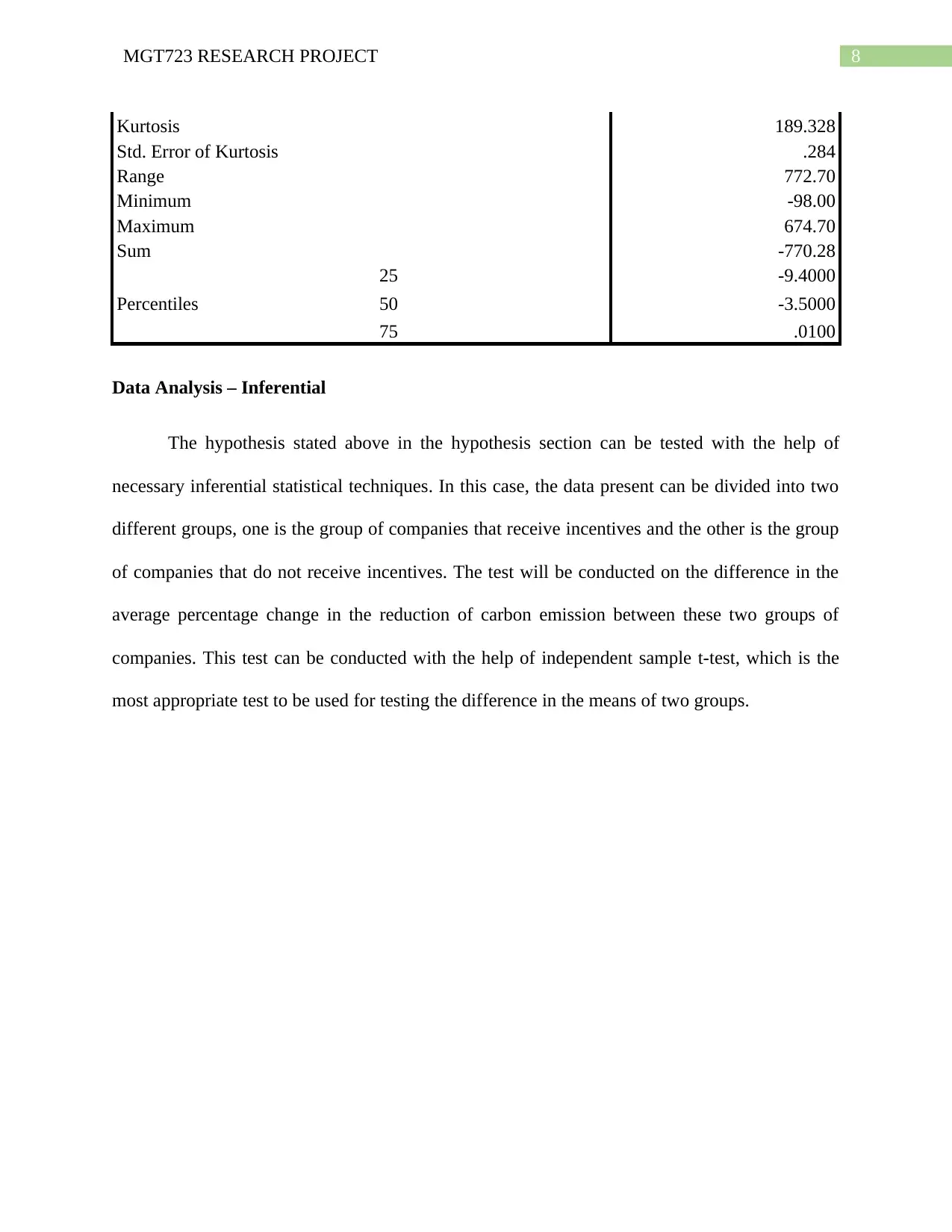
8MGT723 RESEARCH PROJECT
Kurtosis 189.328
Std. Error of Kurtosis .284
Range 772.70
Minimum -98.00
Maximum 674.70
Sum -770.28
Percentiles
25 -9.4000
50 -3.5000
75 .0100
Data Analysis – Inferential
The hypothesis stated above in the hypothesis section can be tested with the help of
necessary inferential statistical techniques. In this case, the data present can be divided into two
different groups, one is the group of companies that receive incentives and the other is the group
of companies that do not receive incentives. The test will be conducted on the difference in the
average percentage change in the reduction of carbon emission between these two groups of
companies. This test can be conducted with the help of independent sample t-test, which is the
most appropriate test to be used for testing the difference in the means of two groups.
Kurtosis 189.328
Std. Error of Kurtosis .284
Range 772.70
Minimum -98.00
Maximum 674.70
Sum -770.28
Percentiles
25 -9.4000
50 -3.5000
75 .0100
Data Analysis – Inferential
The hypothesis stated above in the hypothesis section can be tested with the help of
necessary inferential statistical techniques. In this case, the data present can be divided into two
different groups, one is the group of companies that receive incentives and the other is the group
of companies that do not receive incentives. The test will be conducted on the difference in the
average percentage change in the reduction of carbon emission between these two groups of
companies. This test can be conducted with the help of independent sample t-test, which is the
most appropriate test to be used for testing the difference in the means of two groups.
⊘ This is a preview!⊘
Do you want full access?
Subscribe today to unlock all pages.

Trusted by 1+ million students worldwide
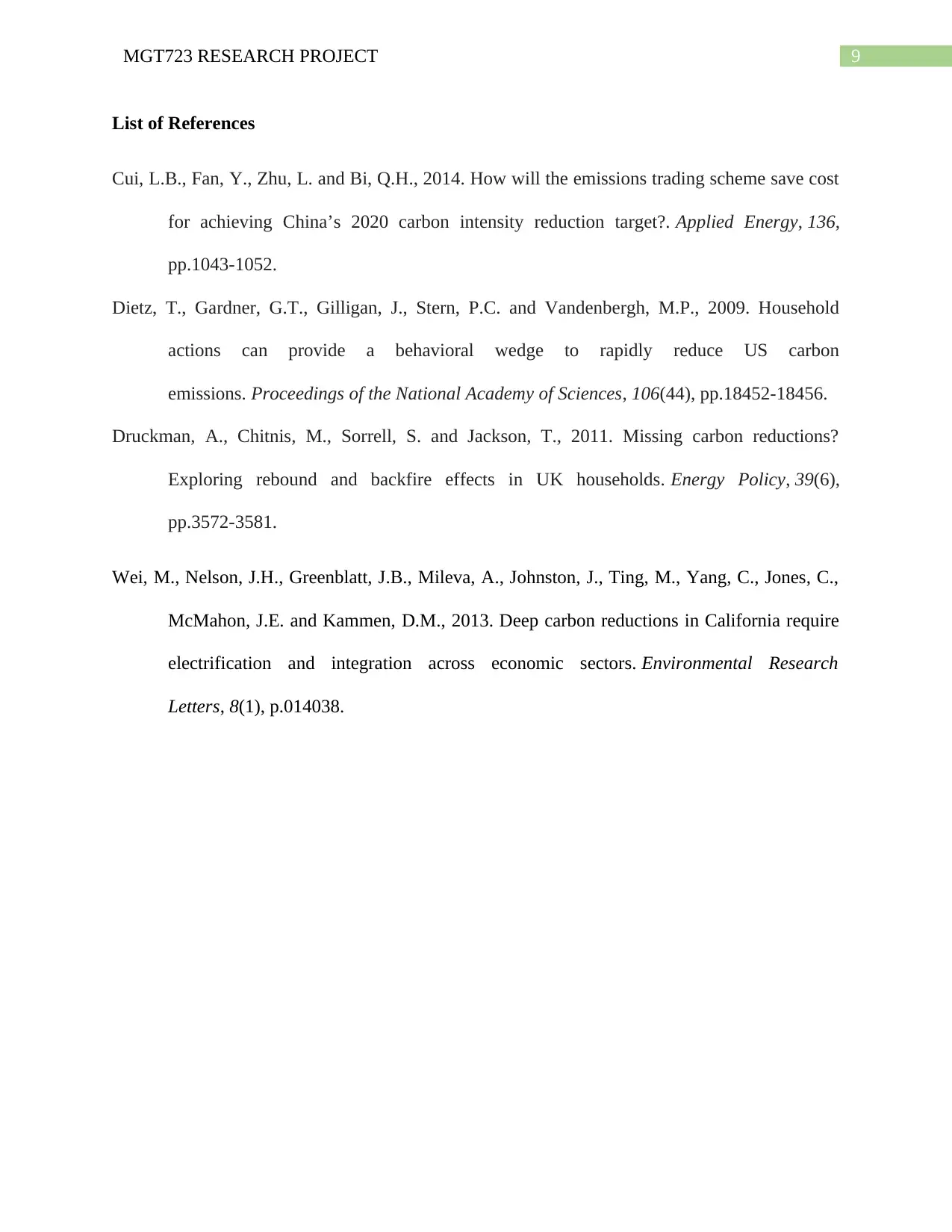
9MGT723 RESEARCH PROJECT
List of References
Cui, L.B., Fan, Y., Zhu, L. and Bi, Q.H., 2014. How will the emissions trading scheme save cost
for achieving China’s 2020 carbon intensity reduction target?. Applied Energy, 136,
pp.1043-1052.
Dietz, T., Gardner, G.T., Gilligan, J., Stern, P.C. and Vandenbergh, M.P., 2009. Household
actions can provide a behavioral wedge to rapidly reduce US carbon
emissions. Proceedings of the National Academy of Sciences, 106(44), pp.18452-18456.
Druckman, A., Chitnis, M., Sorrell, S. and Jackson, T., 2011. Missing carbon reductions?
Exploring rebound and backfire effects in UK households. Energy Policy, 39(6),
pp.3572-3581.
Wei, M., Nelson, J.H., Greenblatt, J.B., Mileva, A., Johnston, J., Ting, M., Yang, C., Jones, C.,
McMahon, J.E. and Kammen, D.M., 2013. Deep carbon reductions in California require
electrification and integration across economic sectors. Environmental Research
Letters, 8(1), p.014038.
List of References
Cui, L.B., Fan, Y., Zhu, L. and Bi, Q.H., 2014. How will the emissions trading scheme save cost
for achieving China’s 2020 carbon intensity reduction target?. Applied Energy, 136,
pp.1043-1052.
Dietz, T., Gardner, G.T., Gilligan, J., Stern, P.C. and Vandenbergh, M.P., 2009. Household
actions can provide a behavioral wedge to rapidly reduce US carbon
emissions. Proceedings of the National Academy of Sciences, 106(44), pp.18452-18456.
Druckman, A., Chitnis, M., Sorrell, S. and Jackson, T., 2011. Missing carbon reductions?
Exploring rebound and backfire effects in UK households. Energy Policy, 39(6),
pp.3572-3581.
Wei, M., Nelson, J.H., Greenblatt, J.B., Mileva, A., Johnston, J., Ting, M., Yang, C., Jones, C.,
McMahon, J.E. and Kammen, D.M., 2013. Deep carbon reductions in California require
electrification and integration across economic sectors. Environmental Research
Letters, 8(1), p.014038.
1 out of 10
Related Documents
Your All-in-One AI-Powered Toolkit for Academic Success.
+13062052269
info@desklib.com
Available 24*7 on WhatsApp / Email
![[object Object]](/_next/static/media/star-bottom.7253800d.svg)
Unlock your academic potential
© 2024 | Zucol Services PVT LTD | All rights reserved.





